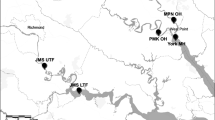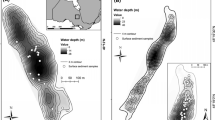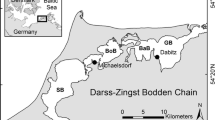Abstract
Changing light availability may be responsible for the discontinuous distribution of submersed aquatic macrophytes in the freshwater tidal Potomac River. During the 1985–1986 growing seasons, light attenuation and chlorophylla and suspended particulate material concentrations were measured in an unvegetated reach (B) and in two adjacent vegetated reaches (A and C). Light attenuation in reach B (the lower, fresh to oligohaline tidal river) was greater than that in reach A (the recently revegetated, upper, freshwater tidal river) in both years. Reach B light attenuation was greater than that in reach C (the vegetated, oligohaline to mesohaline transition zone of the Potomac Estuary) in 1985 and similar to that in reach C in 1986. In reach B, 5% of total below-surface light penetrated only an average of 1.3 m in 1985 and 1.0m in 1986, compared with 1.9 m and 1.4 m in reach A in 1985 and 1986, respectively. Water column chlorophylla concentration controlled light availability in reaches A and B in 1985, whereas both chlorophylla and suspended particulate material concentrations were highly correlated with attenuation in both reaches in 1986. Reach C light attenuation was correlated with suspended particulate material in 1986. The relationship between attenuation coefficient and Secchi depth was KPAR=1.38/Secchi depth. The spectral distribution of light at 1 m was shifted toward the red portion of the visible spectrum compared to surface light. Blue light was virtually absent at 1.0 m in reach B during July and August 1986. Tidal range is probably an important factor in determining light availability for submersed macrophyte propagule survival at the sediment-water interface in this shallow turbid system.
Similar content being viewed by others
Literature Cited
Agami, M., S. Beer, andY. Waesel. 1980. Growth and photosynthesis ofNajas marina L. as affected by light intensity.Aquatic Botany 9:285–289.
Agami, M., S. Beer, andY. Waisel. 1984. Seasonal variations in the growth capacity ofNajas marina L. as a function of various water depths at the Yarhon Springs, Israel.Aquatic Botany 19:45–51.
Bennett, J. P., J. W. Woodward, andD. J. Shultz. 1986. Effect of discharge on the chlorophyll-a distribution in the tidally-influenced Potomac River.Estuaries 9:250–260.
Blanchard, S. F., R. H. Coupe, Jr., and J. C. Woodward. 1982. Water quality of the tidal Potomac River and Estuary, hydrologic data report, 1981 water year. United States Geological Survey Open-File Rep. 82-575. 298 p.
Bodkin, P. C., U. Posluszny, andH. M. Dale. 1980. Light and pressure in two freshwater lakes and their influence on the growth, morphology and depth limits ofHippuris vulgaris.Freshwater Biology 10:545–552.
Bowes, G., T. K. Van, L. A. Garrard, andW. T. Haller. 1977. Adaptation to low light levels byHydrilla.Journal of Aquatic Plant Management 15:32–35.
Buesa, R. J. 1975. Population biomass and metabolic rates of marine angiosperms on the northwestern Cuban shelf.Aquatic Botany 1:11–23.
Bulthuis, D. A. 1982. Effects of in situ light reduction of density and growth of the seagrassHeterozostera tasmanica (Martens ex Aschers.) den Hartog, in Western Port Victoria, Australia.Journal of Experimental Marine Biology and Ecology 67:91–103.
Callender, E., V. Carter, D. C. Hahl, K. Hitt, and B. Schultz (eds.). 1984. A water-quality study of the tidal Potomac River and Estuary—An overview. United States Geological Survey Water-Sup. Pap. 2233. 46 p.
Carpenter, S. R., andD. M. Lodge. 1986. Effects of submersed macrophytes on ecosystem processes.Aquatic Botany 26:341–370.
Carter, V. andN. B. Rybicki. 1985. The effects of grazers and light penetration on the survival of transplants ofVallisneria americana Michx. in the tidal Potomac River, Maryland.Aquatic Botany 23:197–213.
Carter, V. andN. B. Rybicki. 1986. Resurgence of submersed aquatic macrophytes in the tidal Potomac River.Estuaries 9:368–375.
Carter, V., J. W. Barko, G. L. Godshalk, andN. B. Rybicki. 1988. Effects of submersed macrophytes on water quality in the tidal Potomac River, Maryland.Journal of Freshwater Ecology 4:493–501.
Carter, V., J. E. Paschal, Jr., and N. Bartow. 1985. Distribution and abundance of submersed aquatic vegetation in the tidal Potomac River and Estuary, Maryland and Virginia, May 1978 to November 1981. United States Geological Survey Water-Sup. Pap. 2234-A. 46 p.
Chambers, P. A. andJ. Kalff. 1985. Depth distribution and biomass of submersed aquatic macrophyte communities in relation to Secchi depth.Canadian Journal of Fisheries and Aquatic Science 42:701–709.
Chambers, P. A. andE. E. Prepas. 1988. Underwater spectral attenuation and its effect on the maximum depth of angiosperm colonization.Canadian Journal of Fisheries and Aquatic Science 45:1010–1017.
Champ, M. A., G. A. Gould III,W. E. Bozzo, S. G. Ackleson, andK. C. Vierra. 1980. Characterization of light extinction and attenuation in Chesapeake Bay, August 1977, p. 263–277.In V. S. Kennedy (ed.), Estuarine Perspectives. Academic Press, New York.
Conover, W. J. andR. L. Iman. 1981. Rank transformation as a bridge between parametric and nonparametric statistics.The American Statistician 35:124–129.
Dennison, W. C. 1987. Effects of light on seagrass photosynthesis, growth and depth distributions.Aquatic Botany 27:15–26.
Dennison, W. C. andR. S. Alberte. 1982. Photosynthetic response ofZostera marina L. (eelgrass) to in situ manipulations of light intensity.Oecologia 55:137–144.
Dennison, W. C. andR. S. Alberte. 1985. Role of daily light period in the depth distribution ofZostera marina (eelgrass).Marine Ecology Progress Series 25:51–61.
Dennison, W. C. andR. S. Alberte. 1986. Photoadaptation and growth ofZostera marina L. (eelgrass) transplants along a depth gradient.Journal of Experimental Marine Biology and Ecology 98:265–282.
Goldsborough, W. J. andW. M. Kemp. 1988. Light response of a submersed macrophyte: Implications for survival in turbid tidal waters.Ecology 69:1775–1786.
Haramis, G. M. andV. Carter. 1983. Distribution of submersed aquatic macrophytes in the tidal Potokac River.Aquatic Botany 15:64–79.
Jaworski, N. A., D. W. Lear, Jr., andO. Villa, Jr. 1971. Nutrient management in the Potomac Estuary, p. 246–273.In G. E. Likens (ed.), Nutrients and Eutrophication: The Limiting Nutrient Controversy. American Society of Limnology and Oceanography, Inc., Lawrence, Kansas.
Jones, R. C., K. Walti, andM. S. Adams. 1983. Phytoplankton as a factor in the decline of the submersed macrophyteMyriophyllum spicatum L. in Lake Wingra, Wisconsin, USA.Hydrobiologia 107:213–219.
Jupp, B. P., andD. H. N. Spence. 1977. Limitations of macrophytes in a eutrophic lake, Loch Leven, 1. Effects of phytoplankton.Journal of Ecology 65:175–186.
Kemp, W. M., R. R. Twilley, J. C. Stevenson, W. R. Boynton, andJ. C. Means. 1983. The decline of submerged vascular plants in upper Chesapeake Bay: Summary of results concerning possible causes.Marine Technology Society Journal 17:78–79.
Kirk, J. T. O. 1976. Yellow substance (gelbstoff) and its contribution to the attenuation of photosynthetically active refraction in some inland and coastal southeastern Australian waters.Australian Journal of Marine and Freshwater Research 26:61–71.
Kirk, J. T. O. 1979. Spectral distribution of photosynthetically active radiation in some southeastern Australian waters.Australian Journal of Marine and Freshwater Research 30:81–91.
Kirk, J. T. O. 1986. Light and Photosynthesis in Aquatic Ecosystems. Cambridge University Press, New York. 401 p.
Meyer, B. S. andA. C. Heritage. 1941. Effect of turbidity and depth of immersion in apparent photosynthesis inCeratophyllum demersum L.Ecology 22:17–22.
Moss, B. 1979. Algal and other fossil evidence for major changes in Strumpshaw Broad, Norfolk, England, in the last two centuries.British Phycological Journal 14:263–283.
Moss, B. 1983. The Norfolk Broadland: Experiments in the restoration of a complex wetland.Biological Review 58:521–561.
Orth, R. J. andJ. van Montfrans. 1984. Epiphyte-seagrass relationships with an emphasis on the role of micrograzing: A review.Aquatic Botany 18:43–69.
Orth, R., J. Simons, J. Capelli, V. Carter, L. Hindman, S. Hodges, K. Moore, andN. B. Rybicki. 1987. Distribution of submerged aquatic vegetation in the Chesapeake Bay and tributaries and chincoteague Bay—1986. Virginia Institute of Marine Science. Gloucester Point, Virginia. 180 p.
Pennock, J. R. 1985. Chlorophyll distributions in the Delaware Estuary: Regulation by light-limitation.Estuarine, Coastal and Shelf Science 21:711–725.
Pheiffer, T. H., D. R. Donnelly, and D. A. Possehl. 1972. Water quality conditions in the Chesapeake Bay system. Environmental Protection Agency Technical Report 55.
Phillips, G. L., D. Eminson, andB. Moss. 1978. A mechanism to account for macrophyte decline in progressively eutrophicated freshwaters.Aquatic Botany 4:103–126.
Pierce, J. W., D. L. Correll, B. Goldberg, M. A. Faust, andW. H. Klein. 1986. Response of underwater light transmittance in the Rhode River Estuary to changes in water-quality parameters.Estuaries 9:169–178.
Skougstad, M. W., M. J. Fishman, L. D. Friedmann, D. E. Erdmann, and S. S. Duncan (eds.). 1979. Method for Determination of Inorganic Substances in Water and Fluvial Sediments. United States Geological Survey Technique of Water-Resources Investigation, Book 5, Chapter A1. 626 p.
Spence, D. H. N. 1976. Light and plant response in freshwater. p. 93–133.In Light as an Ecological Factor. Proceedings, Sixteenth Symposium of the British Ecological Society, 1974. Blackwell Sci. Pub., London.
Thompson, M. J., L. E. Gilliland, andL. K. Rosenfield. 1979. Light scattering and extinction in a highly turbid coastal inlet.Estuaries 2:164–171.
Tobiessen, P. andP. D. Snow. 1984. Temperature and light effects on the growth ofPotamogeton crispus in Colleus Lake, New York State.Canadian Journal of Botany 62:2822–2826.
United States Department of Commerce. 1985. Tide Tables 1986—East Coast of North and South America. National Oceanic and Atmospheric Administration, National Ocean Survey. 293 p.
Van, T. K., W. T. Haller, andG. Bowes. 1976. Comparison of the photosynthetic characteristics of three submerged aquatic plants.Plant Physiology 58:761–768.
Wetzel, R. G. 1983. Attached algal-substrata interaction: Fact or myth, and when and how?, p. 207–214.In R. G. Wetzel (ed.), Periphyton of Freshwater Ecosystems. Junk Publishers, Boston, Massachusetts.
Wilkerson, R. E. 1963. Effects of light intensity and temperature on the growth of waterstargrass, coontail and duckweed.Weeds 11:287–290.
Author information
Authors and Affiliations
Additional information
Use of trade names in this report is for identification purposes only and does not constitute endorsement by the United States Geological Survey.
Rights and permissions
About this article
Cite this article
Carter, V., Rybicki, N.B. Light attenuation and submersed macrophyte distribution in the tidal Potomac River and estuary. Estuaries 13, 441–452 (1990). https://doi.org/10.2307/1351788
Received:
Accepted:
Issue Date:
DOI: https://doi.org/10.2307/1351788




